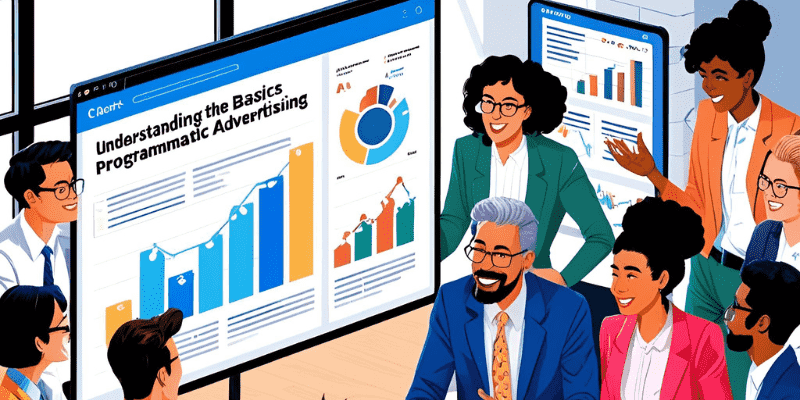Understanding the Basics of Programmatic Advertising
Published: 02/Apr/2025
In today’s digital world, advertising has become smarter, faster, and more efficient. Businesses no longer rely on manual negotiations or guesswork to reach their audience. Instead, they use programmatic advertising, a revolutionary method that automates the process of buying and selling ads in real time.
But what exactly does that mean? You’ve likely encountered programmatic advertising if you’ve ever noticed ads that seem tailored specifically for you, whether on a website, social media, or even a streaming service. Unlike traditional advertising, where businesses buy ad space directly from publishers, programmatic advertising relies on AI and automation to ensure that the right ad reaches the right person at the right time.

So, how does it work? Imagine a digital auction happening in milliseconds every time someone visits a webpage. Advertisers bid for ad space in real time, and the highest bidder’s ad is instantly displayed to the visitor. This process, called real-time bidding (RTB), ensures efficiency, accuracy, and cost-effectiveness.
Why does this matter for businesses? Programmatic advertising offers better targeting, improved ROI, and data-driven decision-making. Instead of wasting money on ads that may never reach the right audience, brands can use programmatic platforms to optimize their campaigns continuously.
In this guide, we’ll explore the basics of programmatic advertising, how it works, its benefits, different types, and real-world examples. Whether you’re a business owner, marketer, or just curious about digital advertising, this article will help you understand why programmatic advertising is shaping the future of online marketing.
What is programmatic advertising?
The basics of programmatic advertising involve using AI and automation to buy and sell digital ads in real-time. Unlike traditional ad buying, which requires human negotiations, programmatic advertising relies on advanced software to place ads where they will be most effective. This method ensures advertisers reach the right audience at the right time.
How Does Programmatic Advertising Work?
At its core, programmatic advertising works through automated systems that analyze data and decide which ads to show to which users. Here’s a step-by-step breakdown:
- Advertisers Set Goals: Businesses define their target audience, campaign objectives, and budget.
- Real-Time Bidding (RTB) Begins: When a user visits a website, an auction occurs instantly to determine which ad gets displayed.
- Highest Bid Wins: The advertiser willing to pay the most for that user’s impression wins the ad space.
- Ad Displays Instantly: The selected ad is shown on the webpage within milliseconds.
- AI Optimization: AI analyzes engagement and refines targeting strategies for better performance.
Benefits of Programmatic Advertising
Why should businesses invest in programmatic digital advertising? Here are some of the biggest advantages:
- Better Targeting: Programmatic advertising allows advertisers to reach their ideal customers based on location, demographics, and online behavior.
- Cost-Effective: Advertisers only pay for impressions that matter, reducing wasted ad spend.
- Faster Transactions: Automation eliminates the need for lengthy negotiations, making ad buying instant and efficient.
- Data-Driven Decisions: AI-driven insights help advertisers optimize campaigns in real time.
- Scalability: Advertisers can reach a global audience across multiple devices and platforms.
Types of Programmatic Advertising
There are different types of programmatic advertising platforms, each serving various needs.
1. Real-Time Bidding (RTB)
Also called an open auction, this method allows multiple advertisers to bid for an ad space in real time. The highest bidder gets the placement, making it a cost-effective way to reach a broad audience.
2. Private Marketplace (PMP)
In a private marketplace, publishers invite specific advertisers to bid for premium ad space. This setup provides more control over ad placements and brand safety.
3. Programmatic Direct
In programmatic direct, an advertiser buys a fixed number of impressions from a publisher without going through an auction. This guarantees ad placement and pricing.
4. Preferred Deals
Advertisers get early access to ad inventory before it goes to auction, allowing them to negotiate fixed prices while maintaining control over where their ads appear.
Programmatic Advertising Examples
To understand the basics of programmatic advertising with examples, here are real-world case studies:
1. Nike’s Personalized Ad Campaign
Nike used programmatic advertising to target sports fans with personalized ads based on browsing history and location. This strategy increased customer engagement and sales significantly.
2. McDonald’s Dynamic Ads
McDonald’s leveraged programmatic ads to show different promotions depending on the time of day and weather conditions. If it was a hot day, users saw ads for cold beverages.
3. Airbnb’s Retargeting Strategy
Airbnb used programmatic advertising to retarget users who visited their website but didn’t book. By showing relevant ads, they significantly increased their booking rates.
Basics of Ad Placement in Programmatic Advertising
Ad placement plays a crucial role in programmatic advertising. Here are the key formats:
- Display Ads: Banner ads appearing on websites and apps.
- Video Ads: Short promotional clips before or during online video content.
- Native Ads: Ads that blend seamlessly with website content for a non-intrusive experience.
- Social Media Ads: Targeted ads on platforms like Facebook, Instagram, and LinkedIn.
- Connected TV Ads: Digital ads appearing on streaming services like Hulu and YouTube TV.
Basics of Advertising Techniques in Programmatic Advertising
Understanding the basics of advertising techniques helps businesses improve their ad campaigns. Here are some effective strategies:
1. Audience Segmentation
Dividing audiences into smaller groups based on interests, location, and online behavior ensures more relevant ad delivery.
2. Retargeting
Showing ads to users who have previously interacted with a brand keeps them engaged and increases conversions.
3. A/B Testing
Comparing different versions of an ad helps determine which performs best, optimizing campaign results.
4. Contextual Targeting
Placing ads on websites relevant to the industry increases engagement and improves ad performance.
Basics: Functions of Advertising in Programmatic Campaigns
The basic functions of advertising remain the same in programmatic advertising, but with added efficiency:
- Informing: Educates consumers about products and services.
- Persuading: Encourages users to take action through compelling messages.
- Reminder: Keeps a brand in consumers’ minds over time.
- Reinforcing: Builds long-term brand loyalty through repeated exposure.
Future of Programmatic Advertising
As technology advances, the basics of programmatic advertising will continue to evolve. Here’s what to expect:
- More AI-powered insights: Improved machine learning algorithms for better targeting and ad personalization.
- Greater Emphasis on Privacy: With stricter data regulations, advertisers will adopt new privacy-friendly targeting methods.
- Expansion into TV and Audio Ads: Programmatic advertising will extend beyond digital platforms to traditional media channels.
- Rise of First-Party Data: As third-party cookies phase out, brands will rely more on direct customer data.
You might like these posts!
- The Importance of Sentiment Analysis in Social Media Marketing
- Using Behavioral Targeting to Improve Your Digital Ad Campaigns
FAQs:
1. What is programmatic advertising in simple terms?
Programmatic advertising is an automated way of buying and selling digital ads using AI and data-driven decisions.
2. How does programmatic advertising work?
It works through real-time bidding (RTB), where advertisers bid for ad space in an instant auction, and the highest bid wins.
3. What are the benefits of programmatic advertising?
Key benefits include better audience targeting, cost efficiency, faster transactions, and real-time campaign optimization.
4. What are examples of programmatic advertising?
Brands like Nike, McDonald’s, and Airbnb use programmatic ads for personalized marketing and retargeting strategies.
5. What are the main types of programmatic advertising?
The main types are real-time bidding (RTB), private marketplaces (PMP), programmatic direct, and preferred deals.
6. What is the future of programmatic advertising?
With AI advancements, increased privacy regulations, and expansion into TV and audio, programmatic advertising will continue to grow and adapt.
Conclusion
Understanding the basics of programmatic advertising is essential for businesses aiming to maximize their marketing efforts. With benefits like better targeting, cost savings, and real-time optimization, it’s no surprise that programmatic advertising is dominating the digital ad space.
By leveraging the right programmatic advertising platforms and techniques, businesses can stay ahead of the competition and achieve better ad performance.
You might like these posts!
- Why focus on retargeting ads to increase sales?
- How to Utilize User-Generated Content for Brand Growth?





